Organizational Change (Seven Eleven): Needs, Interventions, and Models
VerifiedAdded on 2021/05/27
|16
|3993
|135
Report
AI Summary
This report analyzes organizational change within Seven Eleven, focusing on the application of various change management models, including Lewis, McKinsey 7-S, and Kotter's models. The paper identifies the needs for change, primarily addressing issues related to franchisee compliance with wage policies and enhancing customer satisfaction. It proposes specific interventions, such as personal, interpersonal, and group process interventions alongside structural interventions, to improve the firm's operations and address internal and external challenges. The report emphasizes the importance of a holistic diagnostic approach to ensure the effective implementation of the proposed changes and offers recommendations for future change introduction and monitoring. The core issues addressed are the absence of compliance with wage policies and the lack of customer satisfaction across different stores, all within the context of Seven Eleven's business model and market position.
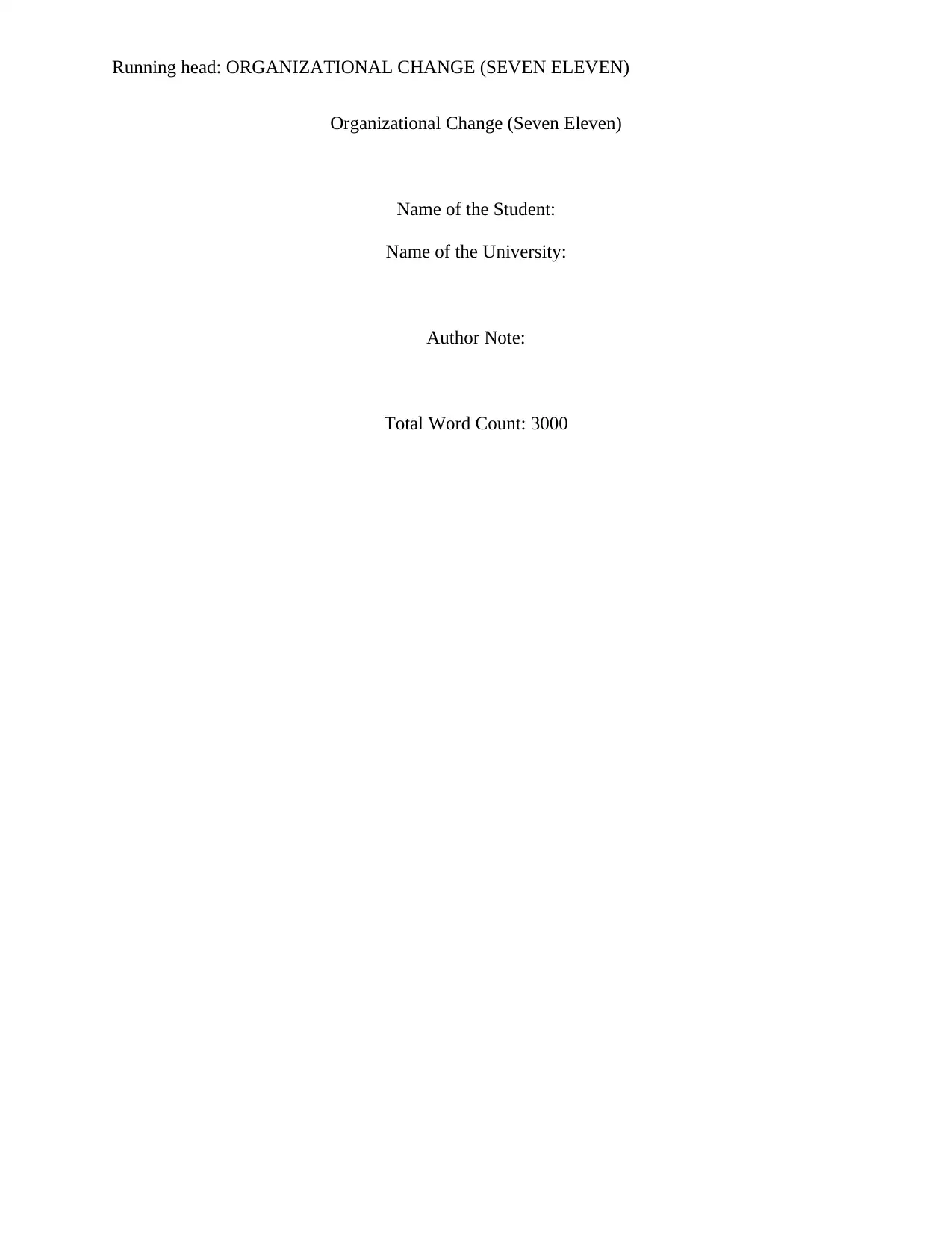
Running head: ORGANIZATIONAL CHANGE (SEVEN ELEVEN)
Organizational Change (Seven Eleven)
Name of the Student:
Name of the University:
Author Note:
Total Word Count: 3000
Organizational Change (Seven Eleven)
Name of the Student:
Name of the University:
Author Note:
Total Word Count: 3000
Paraphrase This Document
Need a fresh take? Get an instant paraphrase of this document with our AI Paraphraser
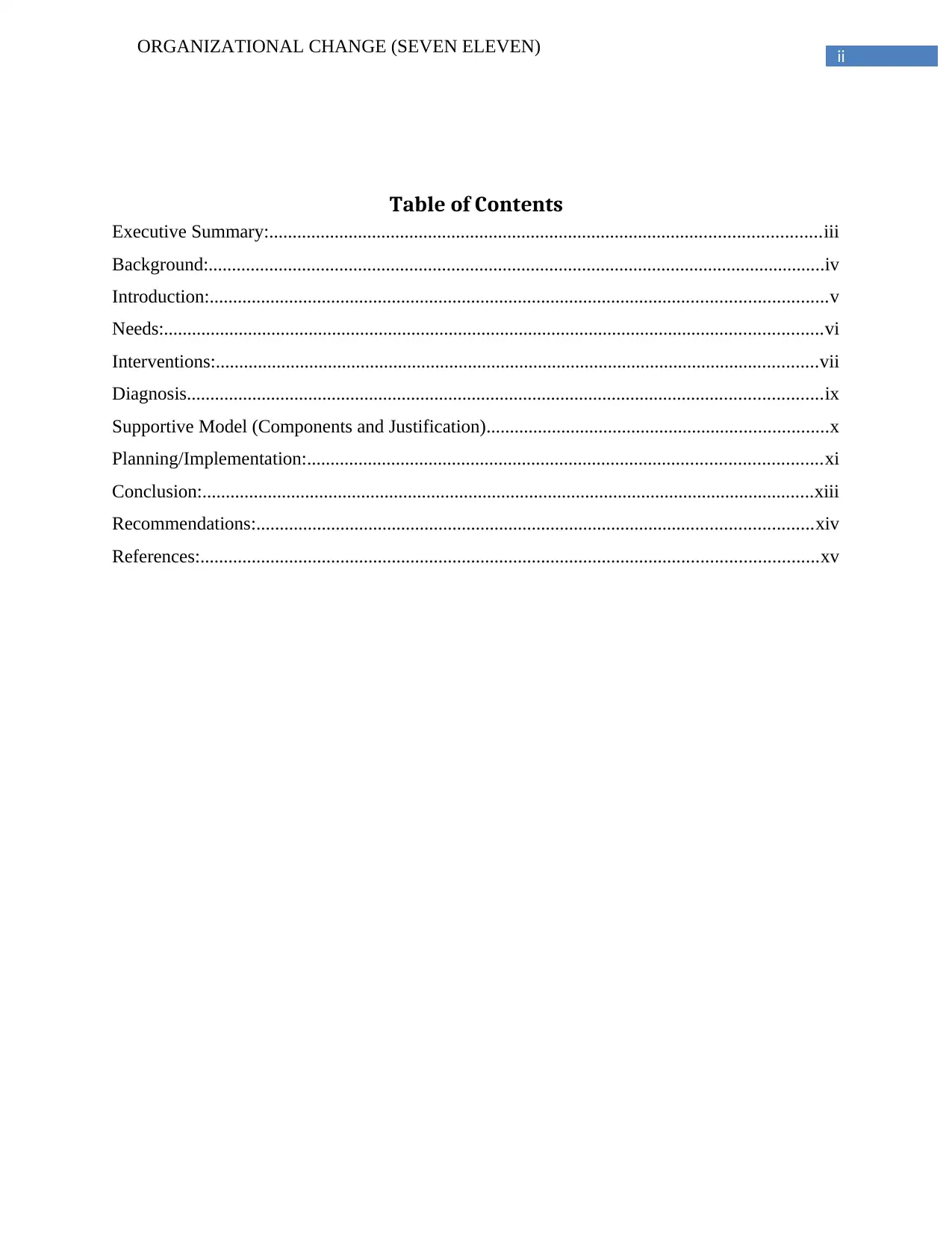
ii
ORGANIZATIONAL CHANGE (SEVEN ELEVEN)
Table of Contents
Executive Summary:......................................................................................................................iii
Background:....................................................................................................................................iv
Introduction:....................................................................................................................................v
Needs:.............................................................................................................................................vi
Interventions:.................................................................................................................................vii
Diagnosis........................................................................................................................................ix
Supportive Model (Components and Justification).........................................................................x
Planning/Implementation:..............................................................................................................xi
Conclusion:...................................................................................................................................xiii
Recommendations:.......................................................................................................................xiv
References:....................................................................................................................................xv
ORGANIZATIONAL CHANGE (SEVEN ELEVEN)
Table of Contents
Executive Summary:......................................................................................................................iii
Background:....................................................................................................................................iv
Introduction:....................................................................................................................................v
Needs:.............................................................................................................................................vi
Interventions:.................................................................................................................................vii
Diagnosis........................................................................................................................................ix
Supportive Model (Components and Justification).........................................................................x
Planning/Implementation:..............................................................................................................xi
Conclusion:...................................................................................................................................xiii
Recommendations:.......................................................................................................................xiv
References:....................................................................................................................................xv
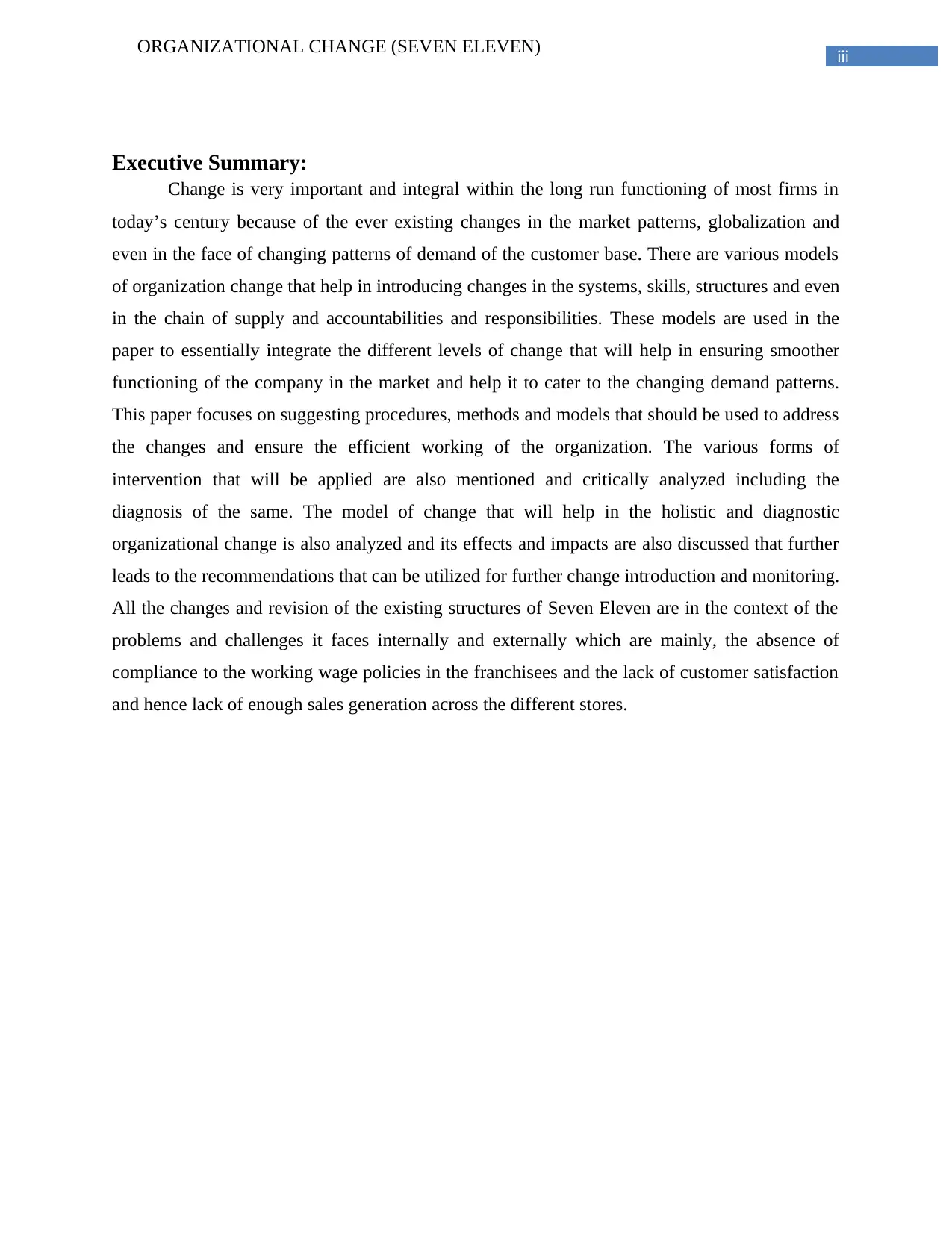
iii
ORGANIZATIONAL CHANGE (SEVEN ELEVEN)
Executive Summary:
Change is very important and integral within the long run functioning of most firms in
today’s century because of the ever existing changes in the market patterns, globalization and
even in the face of changing patterns of demand of the customer base. There are various models
of organization change that help in introducing changes in the systems, skills, structures and even
in the chain of supply and accountabilities and responsibilities. These models are used in the
paper to essentially integrate the different levels of change that will help in ensuring smoother
functioning of the company in the market and help it to cater to the changing demand patterns.
This paper focuses on suggesting procedures, methods and models that should be used to address
the changes and ensure the efficient working of the organization. The various forms of
intervention that will be applied are also mentioned and critically analyzed including the
diagnosis of the same. The model of change that will help in the holistic and diagnostic
organizational change is also analyzed and its effects and impacts are also discussed that further
leads to the recommendations that can be utilized for further change introduction and monitoring.
All the changes and revision of the existing structures of Seven Eleven are in the context of the
problems and challenges it faces internally and externally which are mainly, the absence of
compliance to the working wage policies in the franchisees and the lack of customer satisfaction
and hence lack of enough sales generation across the different stores.
ORGANIZATIONAL CHANGE (SEVEN ELEVEN)
Executive Summary:
Change is very important and integral within the long run functioning of most firms in
today’s century because of the ever existing changes in the market patterns, globalization and
even in the face of changing patterns of demand of the customer base. There are various models
of organization change that help in introducing changes in the systems, skills, structures and even
in the chain of supply and accountabilities and responsibilities. These models are used in the
paper to essentially integrate the different levels of change that will help in ensuring smoother
functioning of the company in the market and help it to cater to the changing demand patterns.
This paper focuses on suggesting procedures, methods and models that should be used to address
the changes and ensure the efficient working of the organization. The various forms of
intervention that will be applied are also mentioned and critically analyzed including the
diagnosis of the same. The model of change that will help in the holistic and diagnostic
organizational change is also analyzed and its effects and impacts are also discussed that further
leads to the recommendations that can be utilized for further change introduction and monitoring.
All the changes and revision of the existing structures of Seven Eleven are in the context of the
problems and challenges it faces internally and externally which are mainly, the absence of
compliance to the working wage policies in the franchisees and the lack of customer satisfaction
and hence lack of enough sales generation across the different stores.
⊘ This is a preview!⊘
Do you want full access?
Subscribe today to unlock all pages.

Trusted by 1+ million students worldwide
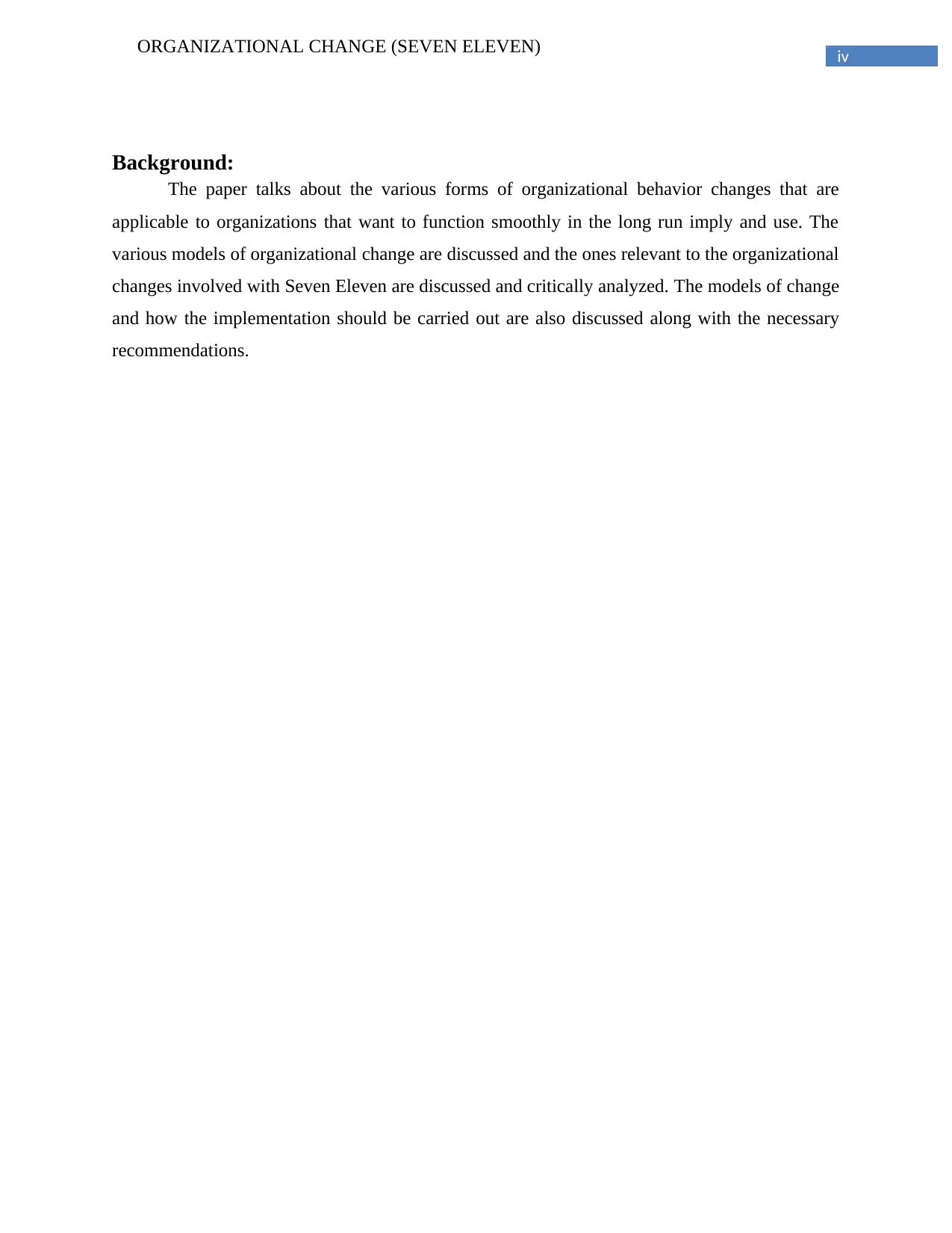
iv
ORGANIZATIONAL CHANGE (SEVEN ELEVEN)
Background:
The paper talks about the various forms of organizational behavior changes that are
applicable to organizations that want to function smoothly in the long run imply and use. The
various models of organizational change are discussed and the ones relevant to the organizational
changes involved with Seven Eleven are discussed and critically analyzed. The models of change
and how the implementation should be carried out are also discussed along with the necessary
recommendations.
ORGANIZATIONAL CHANGE (SEVEN ELEVEN)
Background:
The paper talks about the various forms of organizational behavior changes that are
applicable to organizations that want to function smoothly in the long run imply and use. The
various models of organizational change are discussed and the ones relevant to the organizational
changes involved with Seven Eleven are discussed and critically analyzed. The models of change
and how the implementation should be carried out are also discussed along with the necessary
recommendations.
Paraphrase This Document
Need a fresh take? Get an instant paraphrase of this document with our AI Paraphraser
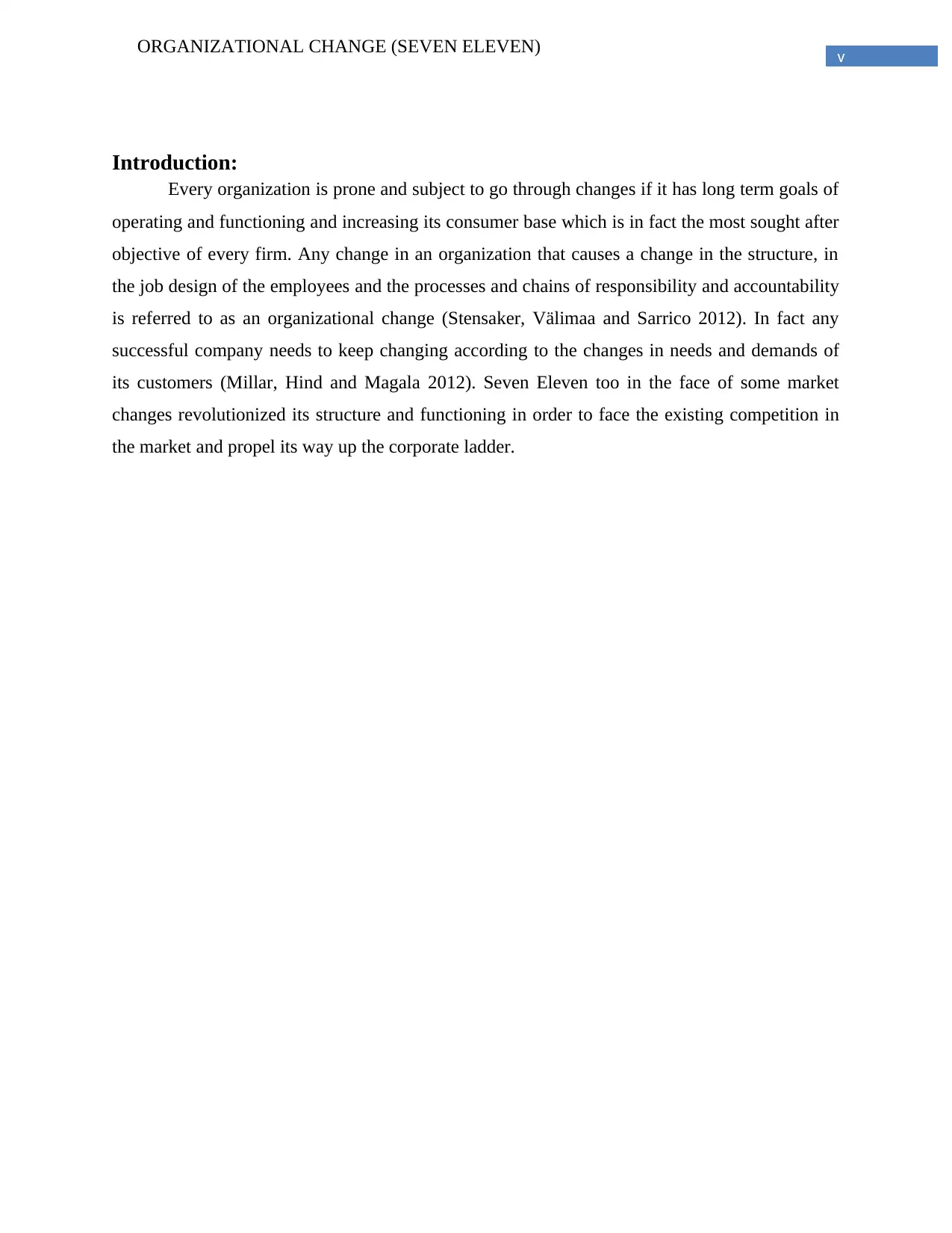
v
ORGANIZATIONAL CHANGE (SEVEN ELEVEN)
Introduction:
Every organization is prone and subject to go through changes if it has long term goals of
operating and functioning and increasing its consumer base which is in fact the most sought after
objective of every firm. Any change in an organization that causes a change in the structure, in
the job design of the employees and the processes and chains of responsibility and accountability
is referred to as an organizational change (Stensaker, Välimaa and Sarrico 2012). In fact any
successful company needs to keep changing according to the changes in needs and demands of
its customers (Millar, Hind and Magala 2012). Seven Eleven too in the face of some market
changes revolutionized its structure and functioning in order to face the existing competition in
the market and propel its way up the corporate ladder.
ORGANIZATIONAL CHANGE (SEVEN ELEVEN)
Introduction:
Every organization is prone and subject to go through changes if it has long term goals of
operating and functioning and increasing its consumer base which is in fact the most sought after
objective of every firm. Any change in an organization that causes a change in the structure, in
the job design of the employees and the processes and chains of responsibility and accountability
is referred to as an organizational change (Stensaker, Välimaa and Sarrico 2012). In fact any
successful company needs to keep changing according to the changes in needs and demands of
its customers (Millar, Hind and Magala 2012). Seven Eleven too in the face of some market
changes revolutionized its structure and functioning in order to face the existing competition in
the market and propel its way up the corporate ladder.
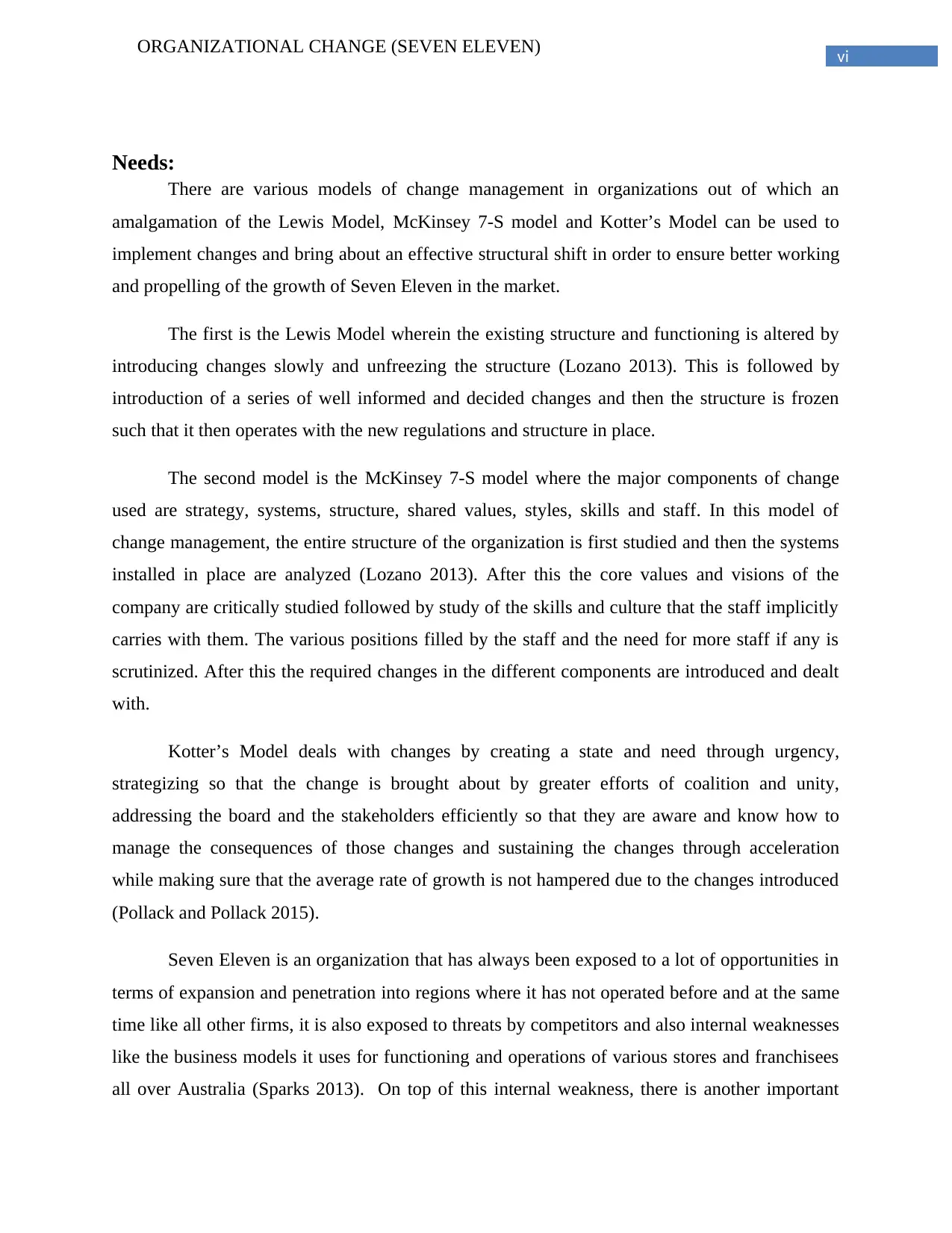
vi
ORGANIZATIONAL CHANGE (SEVEN ELEVEN)
Needs:
There are various models of change management in organizations out of which an
amalgamation of the Lewis Model, McKinsey 7-S model and Kotter’s Model can be used to
implement changes and bring about an effective structural shift in order to ensure better working
and propelling of the growth of Seven Eleven in the market.
The first is the Lewis Model wherein the existing structure and functioning is altered by
introducing changes slowly and unfreezing the structure (Lozano 2013). This is followed by
introduction of a series of well informed and decided changes and then the structure is frozen
such that it then operates with the new regulations and structure in place.
The second model is the McKinsey 7-S model where the major components of change
used are strategy, systems, structure, shared values, styles, skills and staff. In this model of
change management, the entire structure of the organization is first studied and then the systems
installed in place are analyzed (Lozano 2013). After this the core values and visions of the
company are critically studied followed by study of the skills and culture that the staff implicitly
carries with them. The various positions filled by the staff and the need for more staff if any is
scrutinized. After this the required changes in the different components are introduced and dealt
with.
Kotter’s Model deals with changes by creating a state and need through urgency,
strategizing so that the change is brought about by greater efforts of coalition and unity,
addressing the board and the stakeholders efficiently so that they are aware and know how to
manage the consequences of those changes and sustaining the changes through acceleration
while making sure that the average rate of growth is not hampered due to the changes introduced
(Pollack and Pollack 2015).
Seven Eleven is an organization that has always been exposed to a lot of opportunities in
terms of expansion and penetration into regions where it has not operated before and at the same
time like all other firms, it is also exposed to threats by competitors and also internal weaknesses
like the business models it uses for functioning and operations of various stores and franchisees
all over Australia (Sparks 2013). On top of this internal weakness, there is another important
ORGANIZATIONAL CHANGE (SEVEN ELEVEN)
Needs:
There are various models of change management in organizations out of which an
amalgamation of the Lewis Model, McKinsey 7-S model and Kotter’s Model can be used to
implement changes and bring about an effective structural shift in order to ensure better working
and propelling of the growth of Seven Eleven in the market.
The first is the Lewis Model wherein the existing structure and functioning is altered by
introducing changes slowly and unfreezing the structure (Lozano 2013). This is followed by
introduction of a series of well informed and decided changes and then the structure is frozen
such that it then operates with the new regulations and structure in place.
The second model is the McKinsey 7-S model where the major components of change
used are strategy, systems, structure, shared values, styles, skills and staff. In this model of
change management, the entire structure of the organization is first studied and then the systems
installed in place are analyzed (Lozano 2013). After this the core values and visions of the
company are critically studied followed by study of the skills and culture that the staff implicitly
carries with them. The various positions filled by the staff and the need for more staff if any is
scrutinized. After this the required changes in the different components are introduced and dealt
with.
Kotter’s Model deals with changes by creating a state and need through urgency,
strategizing so that the change is brought about by greater efforts of coalition and unity,
addressing the board and the stakeholders efficiently so that they are aware and know how to
manage the consequences of those changes and sustaining the changes through acceleration
while making sure that the average rate of growth is not hampered due to the changes introduced
(Pollack and Pollack 2015).
Seven Eleven is an organization that has always been exposed to a lot of opportunities in
terms of expansion and penetration into regions where it has not operated before and at the same
time like all other firms, it is also exposed to threats by competitors and also internal weaknesses
like the business models it uses for functioning and operations of various stores and franchisees
all over Australia (Sparks 2013). On top of this internal weakness, there is another important
⊘ This is a preview!⊘
Do you want full access?
Subscribe today to unlock all pages.

Trusted by 1+ million students worldwide
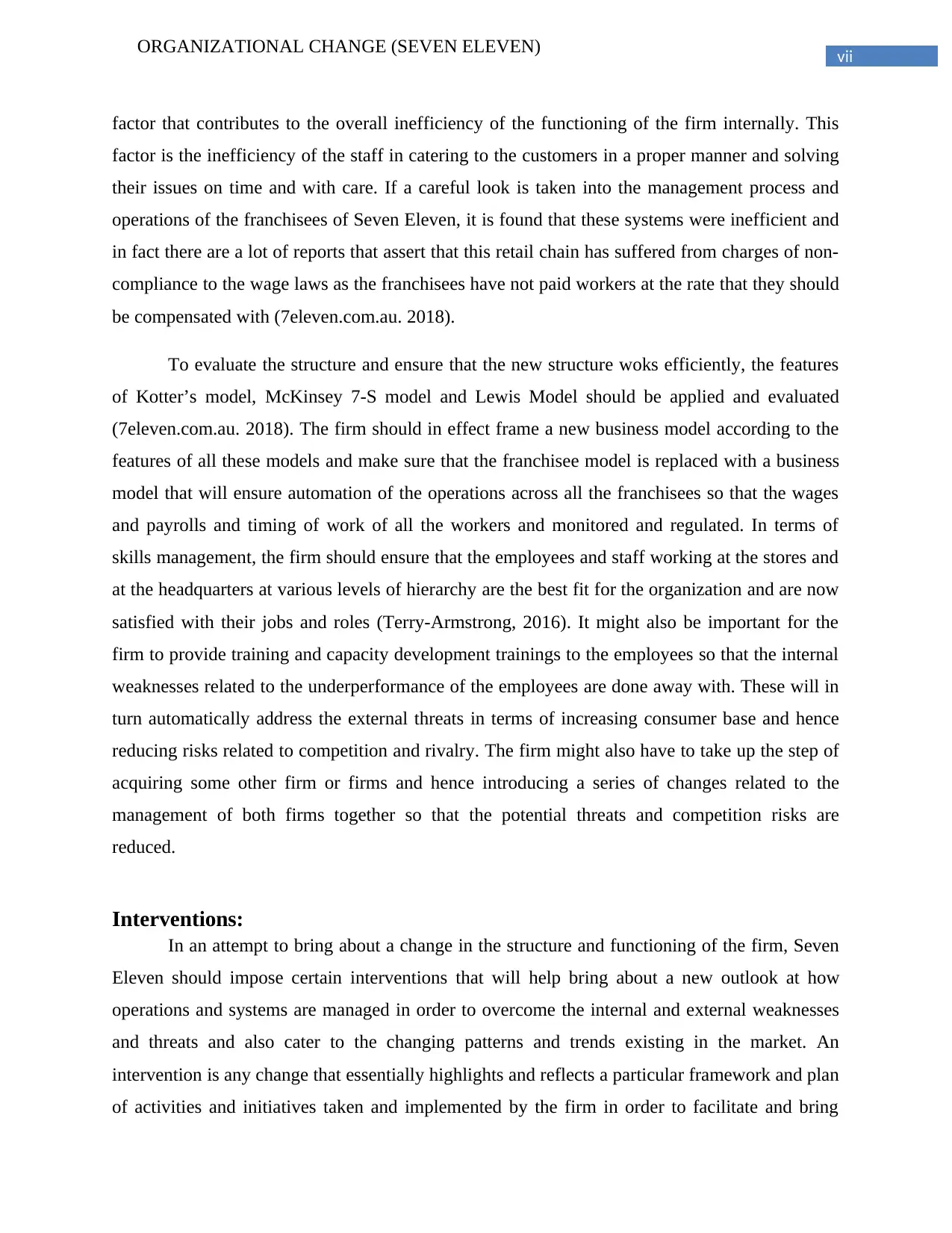
vii
ORGANIZATIONAL CHANGE (SEVEN ELEVEN)
factor that contributes to the overall inefficiency of the functioning of the firm internally. This
factor is the inefficiency of the staff in catering to the customers in a proper manner and solving
their issues on time and with care. If a careful look is taken into the management process and
operations of the franchisees of Seven Eleven, it is found that these systems were inefficient and
in fact there are a lot of reports that assert that this retail chain has suffered from charges of non-
compliance to the wage laws as the franchisees have not paid workers at the rate that they should
be compensated with (7eleven.com.au. 2018).
To evaluate the structure and ensure that the new structure woks efficiently, the features
of Kotter’s model, McKinsey 7-S model and Lewis Model should be applied and evaluated
(7eleven.com.au. 2018). The firm should in effect frame a new business model according to the
features of all these models and make sure that the franchisee model is replaced with a business
model that will ensure automation of the operations across all the franchisees so that the wages
and payrolls and timing of work of all the workers and monitored and regulated. In terms of
skills management, the firm should ensure that the employees and staff working at the stores and
at the headquarters at various levels of hierarchy are the best fit for the organization and are now
satisfied with their jobs and roles (Terry-Armstrong, 2016). It might also be important for the
firm to provide training and capacity development trainings to the employees so that the internal
weaknesses related to the underperformance of the employees are done away with. These will in
turn automatically address the external threats in terms of increasing consumer base and hence
reducing risks related to competition and rivalry. The firm might also have to take up the step of
acquiring some other firm or firms and hence introducing a series of changes related to the
management of both firms together so that the potential threats and competition risks are
reduced.
Interventions:
In an attempt to bring about a change in the structure and functioning of the firm, Seven
Eleven should impose certain interventions that will help bring about a new outlook at how
operations and systems are managed in order to overcome the internal and external weaknesses
and threats and also cater to the changing patterns and trends existing in the market. An
intervention is any change that essentially highlights and reflects a particular framework and plan
of activities and initiatives taken and implemented by the firm in order to facilitate and bring
ORGANIZATIONAL CHANGE (SEVEN ELEVEN)
factor that contributes to the overall inefficiency of the functioning of the firm internally. This
factor is the inefficiency of the staff in catering to the customers in a proper manner and solving
their issues on time and with care. If a careful look is taken into the management process and
operations of the franchisees of Seven Eleven, it is found that these systems were inefficient and
in fact there are a lot of reports that assert that this retail chain has suffered from charges of non-
compliance to the wage laws as the franchisees have not paid workers at the rate that they should
be compensated with (7eleven.com.au. 2018).
To evaluate the structure and ensure that the new structure woks efficiently, the features
of Kotter’s model, McKinsey 7-S model and Lewis Model should be applied and evaluated
(7eleven.com.au. 2018). The firm should in effect frame a new business model according to the
features of all these models and make sure that the franchisee model is replaced with a business
model that will ensure automation of the operations across all the franchisees so that the wages
and payrolls and timing of work of all the workers and monitored and regulated. In terms of
skills management, the firm should ensure that the employees and staff working at the stores and
at the headquarters at various levels of hierarchy are the best fit for the organization and are now
satisfied with their jobs and roles (Terry-Armstrong, 2016). It might also be important for the
firm to provide training and capacity development trainings to the employees so that the internal
weaknesses related to the underperformance of the employees are done away with. These will in
turn automatically address the external threats in terms of increasing consumer base and hence
reducing risks related to competition and rivalry. The firm might also have to take up the step of
acquiring some other firm or firms and hence introducing a series of changes related to the
management of both firms together so that the potential threats and competition risks are
reduced.
Interventions:
In an attempt to bring about a change in the structure and functioning of the firm, Seven
Eleven should impose certain interventions that will help bring about a new outlook at how
operations and systems are managed in order to overcome the internal and external weaknesses
and threats and also cater to the changing patterns and trends existing in the market. An
intervention is any change that essentially highlights and reflects a particular framework and plan
of activities and initiatives taken and implemented by the firm in order to facilitate and bring
Paraphrase This Document
Need a fresh take? Get an instant paraphrase of this document with our AI Paraphraser
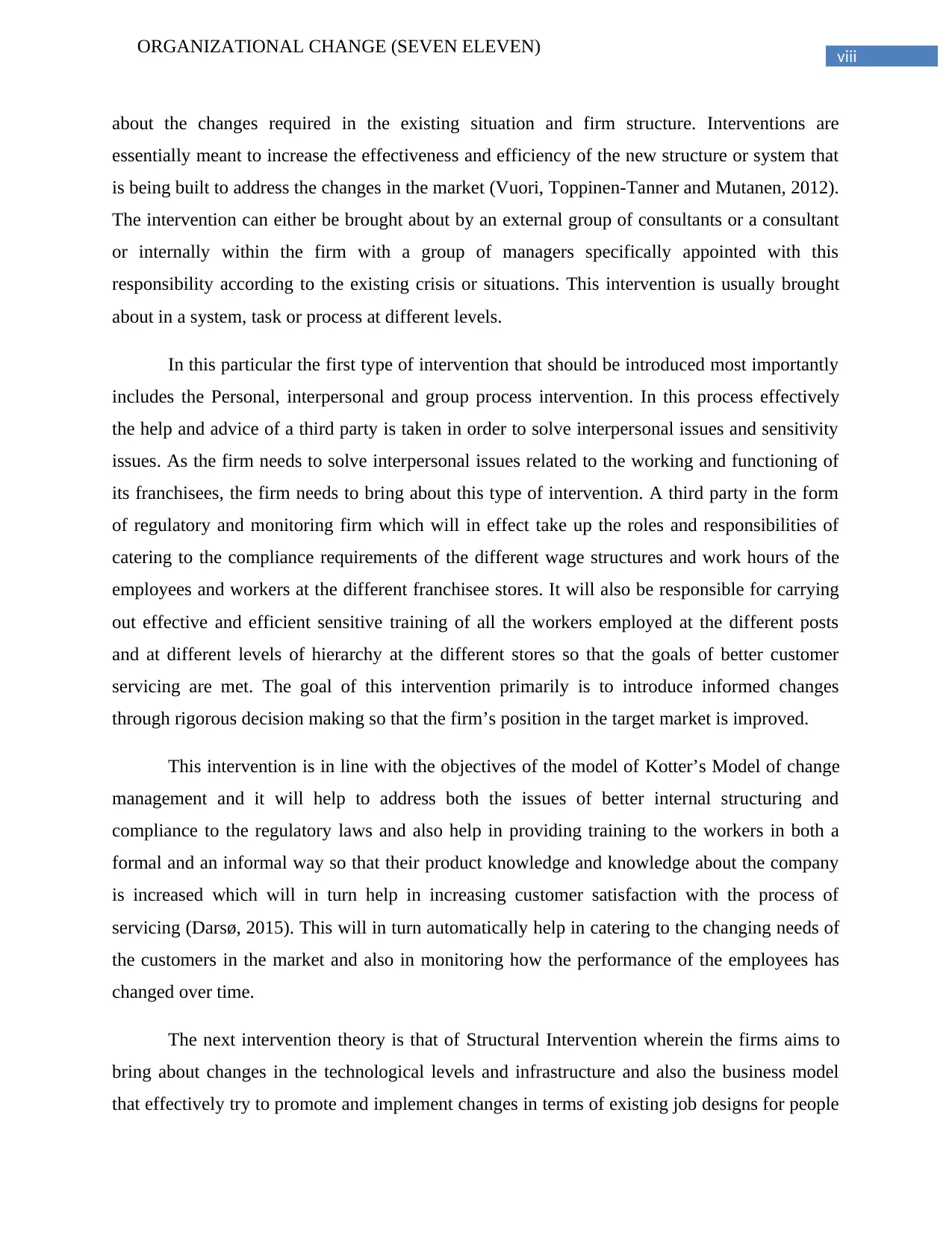
viii
ORGANIZATIONAL CHANGE (SEVEN ELEVEN)
about the changes required in the existing situation and firm structure. Interventions are
essentially meant to increase the effectiveness and efficiency of the new structure or system that
is being built to address the changes in the market (Vuori, Toppinen-Tanner and Mutanen, 2012).
The intervention can either be brought about by an external group of consultants or a consultant
or internally within the firm with a group of managers specifically appointed with this
responsibility according to the existing crisis or situations. This intervention is usually brought
about in a system, task or process at different levels.
In this particular the first type of intervention that should be introduced most importantly
includes the Personal, interpersonal and group process intervention. In this process effectively
the help and advice of a third party is taken in order to solve interpersonal issues and sensitivity
issues. As the firm needs to solve interpersonal issues related to the working and functioning of
its franchisees, the firm needs to bring about this type of intervention. A third party in the form
of regulatory and monitoring firm which will in effect take up the roles and responsibilities of
catering to the compliance requirements of the different wage structures and work hours of the
employees and workers at the different franchisee stores. It will also be responsible for carrying
out effective and efficient sensitive training of all the workers employed at the different posts
and at different levels of hierarchy at the different stores so that the goals of better customer
servicing are met. The goal of this intervention primarily is to introduce informed changes
through rigorous decision making so that the firm’s position in the target market is improved.
This intervention is in line with the objectives of the model of Kotter’s Model of change
management and it will help to address both the issues of better internal structuring and
compliance to the regulatory laws and also help in providing training to the workers in both a
formal and an informal way so that their product knowledge and knowledge about the company
is increased which will in turn help in increasing customer satisfaction with the process of
servicing (Darsø, 2015). This will in turn automatically help in catering to the changing needs of
the customers in the market and also in monitoring how the performance of the employees has
changed over time.
The next intervention theory is that of Structural Intervention wherein the firms aims to
bring about changes in the technological levels and infrastructure and also the business model
that effectively try to promote and implement changes in terms of existing job designs for people
ORGANIZATIONAL CHANGE (SEVEN ELEVEN)
about the changes required in the existing situation and firm structure. Interventions are
essentially meant to increase the effectiveness and efficiency of the new structure or system that
is being built to address the changes in the market (Vuori, Toppinen-Tanner and Mutanen, 2012).
The intervention can either be brought about by an external group of consultants or a consultant
or internally within the firm with a group of managers specifically appointed with this
responsibility according to the existing crisis or situations. This intervention is usually brought
about in a system, task or process at different levels.
In this particular the first type of intervention that should be introduced most importantly
includes the Personal, interpersonal and group process intervention. In this process effectively
the help and advice of a third party is taken in order to solve interpersonal issues and sensitivity
issues. As the firm needs to solve interpersonal issues related to the working and functioning of
its franchisees, the firm needs to bring about this type of intervention. A third party in the form
of regulatory and monitoring firm which will in effect take up the roles and responsibilities of
catering to the compliance requirements of the different wage structures and work hours of the
employees and workers at the different franchisee stores. It will also be responsible for carrying
out effective and efficient sensitive training of all the workers employed at the different posts
and at different levels of hierarchy at the different stores so that the goals of better customer
servicing are met. The goal of this intervention primarily is to introduce informed changes
through rigorous decision making so that the firm’s position in the target market is improved.
This intervention is in line with the objectives of the model of Kotter’s Model of change
management and it will help to address both the issues of better internal structuring and
compliance to the regulatory laws and also help in providing training to the workers in both a
formal and an informal way so that their product knowledge and knowledge about the company
is increased which will in turn help in increasing customer satisfaction with the process of
servicing (Darsø, 2015). This will in turn automatically help in catering to the changing needs of
the customers in the market and also in monitoring how the performance of the employees has
changed over time.
The next intervention theory is that of Structural Intervention wherein the firms aims to
bring about changes in the technological levels and infrastructure and also the business model
that effectively try to promote and implement changes in terms of existing job designs for people
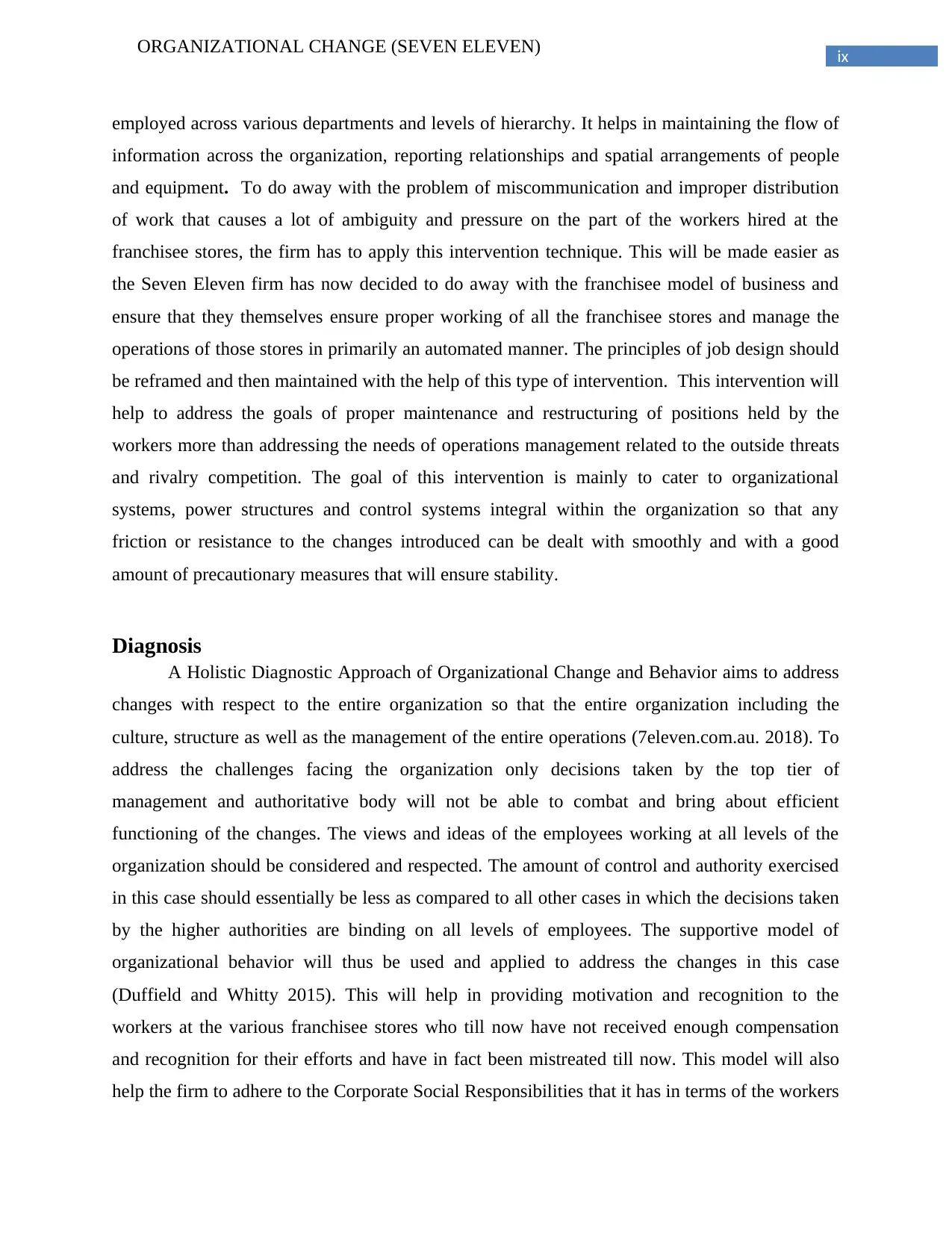
ix
ORGANIZATIONAL CHANGE (SEVEN ELEVEN)
employed across various departments and levels of hierarchy. It helps in maintaining the flow of
information across the organization, reporting relationships and spatial arrangements of people
and equipment. To do away with the problem of miscommunication and improper distribution
of work that causes a lot of ambiguity and pressure on the part of the workers hired at the
franchisee stores, the firm has to apply this intervention technique. This will be made easier as
the Seven Eleven firm has now decided to do away with the franchisee model of business and
ensure that they themselves ensure proper working of all the franchisee stores and manage the
operations of those stores in primarily an automated manner. The principles of job design should
be reframed and then maintained with the help of this type of intervention. This intervention will
help to address the goals of proper maintenance and restructuring of positions held by the
workers more than addressing the needs of operations management related to the outside threats
and rivalry competition. The goal of this intervention is mainly to cater to organizational
systems, power structures and control systems integral within the organization so that any
friction or resistance to the changes introduced can be dealt with smoothly and with a good
amount of precautionary measures that will ensure stability.
Diagnosis
A Holistic Diagnostic Approach of Organizational Change and Behavior aims to address
changes with respect to the entire organization so that the entire organization including the
culture, structure as well as the management of the entire operations (7eleven.com.au. 2018). To
address the challenges facing the organization only decisions taken by the top tier of
management and authoritative body will not be able to combat and bring about efficient
functioning of the changes. The views and ideas of the employees working at all levels of the
organization should be considered and respected. The amount of control and authority exercised
in this case should essentially be less as compared to all other cases in which the decisions taken
by the higher authorities are binding on all levels of employees. The supportive model of
organizational behavior will thus be used and applied to address the changes in this case
(Duffield and Whitty 2015). This will help in providing motivation and recognition to the
workers at the various franchisee stores who till now have not received enough compensation
and recognition for their efforts and have in fact been mistreated till now. This model will also
help the firm to adhere to the Corporate Social Responsibilities that it has in terms of the workers
ORGANIZATIONAL CHANGE (SEVEN ELEVEN)
employed across various departments and levels of hierarchy. It helps in maintaining the flow of
information across the organization, reporting relationships and spatial arrangements of people
and equipment. To do away with the problem of miscommunication and improper distribution
of work that causes a lot of ambiguity and pressure on the part of the workers hired at the
franchisee stores, the firm has to apply this intervention technique. This will be made easier as
the Seven Eleven firm has now decided to do away with the franchisee model of business and
ensure that they themselves ensure proper working of all the franchisee stores and manage the
operations of those stores in primarily an automated manner. The principles of job design should
be reframed and then maintained with the help of this type of intervention. This intervention will
help to address the goals of proper maintenance and restructuring of positions held by the
workers more than addressing the needs of operations management related to the outside threats
and rivalry competition. The goal of this intervention is mainly to cater to organizational
systems, power structures and control systems integral within the organization so that any
friction or resistance to the changes introduced can be dealt with smoothly and with a good
amount of precautionary measures that will ensure stability.
Diagnosis
A Holistic Diagnostic Approach of Organizational Change and Behavior aims to address
changes with respect to the entire organization so that the entire organization including the
culture, structure as well as the management of the entire operations (7eleven.com.au. 2018). To
address the challenges facing the organization only decisions taken by the top tier of
management and authoritative body will not be able to combat and bring about efficient
functioning of the changes. The views and ideas of the employees working at all levels of the
organization should be considered and respected. The amount of control and authority exercised
in this case should essentially be less as compared to all other cases in which the decisions taken
by the higher authorities are binding on all levels of employees. The supportive model of
organizational behavior will thus be used and applied to address the changes in this case
(Duffield and Whitty 2015). This will help in providing motivation and recognition to the
workers at the various franchisee stores who till now have not received enough compensation
and recognition for their efforts and have in fact been mistreated till now. This model will also
help the firm to adhere to the Corporate Social Responsibilities that it has in terms of the workers
⊘ This is a preview!⊘
Do you want full access?
Subscribe today to unlock all pages.

Trusted by 1+ million students worldwide
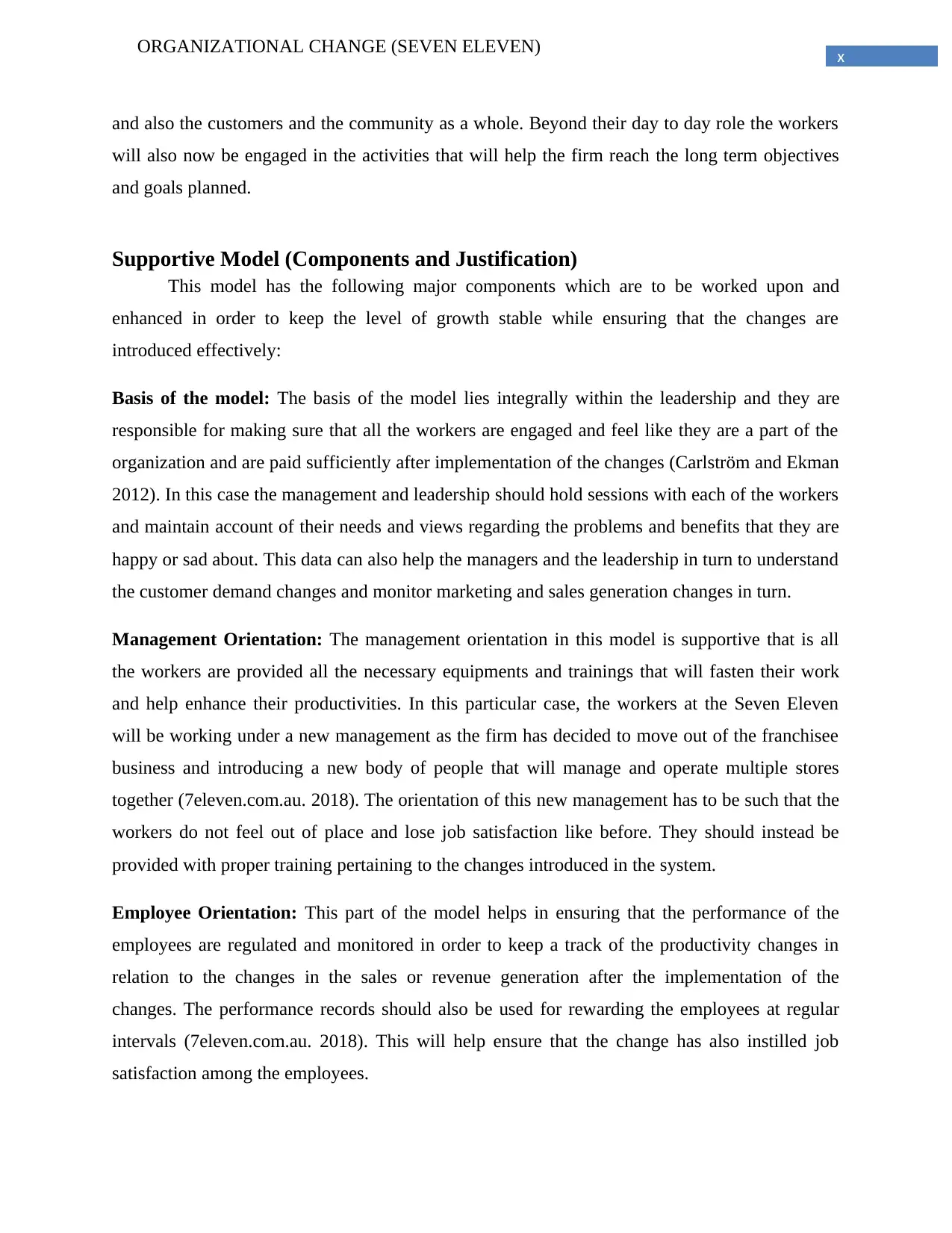
x
ORGANIZATIONAL CHANGE (SEVEN ELEVEN)
and also the customers and the community as a whole. Beyond their day to day role the workers
will also now be engaged in the activities that will help the firm reach the long term objectives
and goals planned.
Supportive Model (Components and Justification)
This model has the following major components which are to be worked upon and
enhanced in order to keep the level of growth stable while ensuring that the changes are
introduced effectively:
Basis of the model: The basis of the model lies integrally within the leadership and they are
responsible for making sure that all the workers are engaged and feel like they are a part of the
organization and are paid sufficiently after implementation of the changes (Carlström and Ekman
2012). In this case the management and leadership should hold sessions with each of the workers
and maintain account of their needs and views regarding the problems and benefits that they are
happy or sad about. This data can also help the managers and the leadership in turn to understand
the customer demand changes and monitor marketing and sales generation changes in turn.
Management Orientation: The management orientation in this model is supportive that is all
the workers are provided all the necessary equipments and trainings that will fasten their work
and help enhance their productivities. In this particular case, the workers at the Seven Eleven
will be working under a new management as the firm has decided to move out of the franchisee
business and introducing a new body of people that will manage and operate multiple stores
together (7eleven.com.au. 2018). The orientation of this new management has to be such that the
workers do not feel out of place and lose job satisfaction like before. They should instead be
provided with proper training pertaining to the changes introduced in the system.
Employee Orientation: This part of the model helps in ensuring that the performance of the
employees are regulated and monitored in order to keep a track of the productivity changes in
relation to the changes in the sales or revenue generation after the implementation of the
changes. The performance records should also be used for rewarding the employees at regular
intervals (7eleven.com.au. 2018). This will help ensure that the change has also instilled job
satisfaction among the employees.
ORGANIZATIONAL CHANGE (SEVEN ELEVEN)
and also the customers and the community as a whole. Beyond their day to day role the workers
will also now be engaged in the activities that will help the firm reach the long term objectives
and goals planned.
Supportive Model (Components and Justification)
This model has the following major components which are to be worked upon and
enhanced in order to keep the level of growth stable while ensuring that the changes are
introduced effectively:
Basis of the model: The basis of the model lies integrally within the leadership and they are
responsible for making sure that all the workers are engaged and feel like they are a part of the
organization and are paid sufficiently after implementation of the changes (Carlström and Ekman
2012). In this case the management and leadership should hold sessions with each of the workers
and maintain account of their needs and views regarding the problems and benefits that they are
happy or sad about. This data can also help the managers and the leadership in turn to understand
the customer demand changes and monitor marketing and sales generation changes in turn.
Management Orientation: The management orientation in this model is supportive that is all
the workers are provided all the necessary equipments and trainings that will fasten their work
and help enhance their productivities. In this particular case, the workers at the Seven Eleven
will be working under a new management as the firm has decided to move out of the franchisee
business and introducing a new body of people that will manage and operate multiple stores
together (7eleven.com.au. 2018). The orientation of this new management has to be such that the
workers do not feel out of place and lose job satisfaction like before. They should instead be
provided with proper training pertaining to the changes introduced in the system.
Employee Orientation: This part of the model helps in ensuring that the performance of the
employees are regulated and monitored in order to keep a track of the productivity changes in
relation to the changes in the sales or revenue generation after the implementation of the
changes. The performance records should also be used for rewarding the employees at regular
intervals (7eleven.com.au. 2018). This will help ensure that the change has also instilled job
satisfaction among the employees.
Paraphrase This Document
Need a fresh take? Get an instant paraphrase of this document with our AI Paraphraser
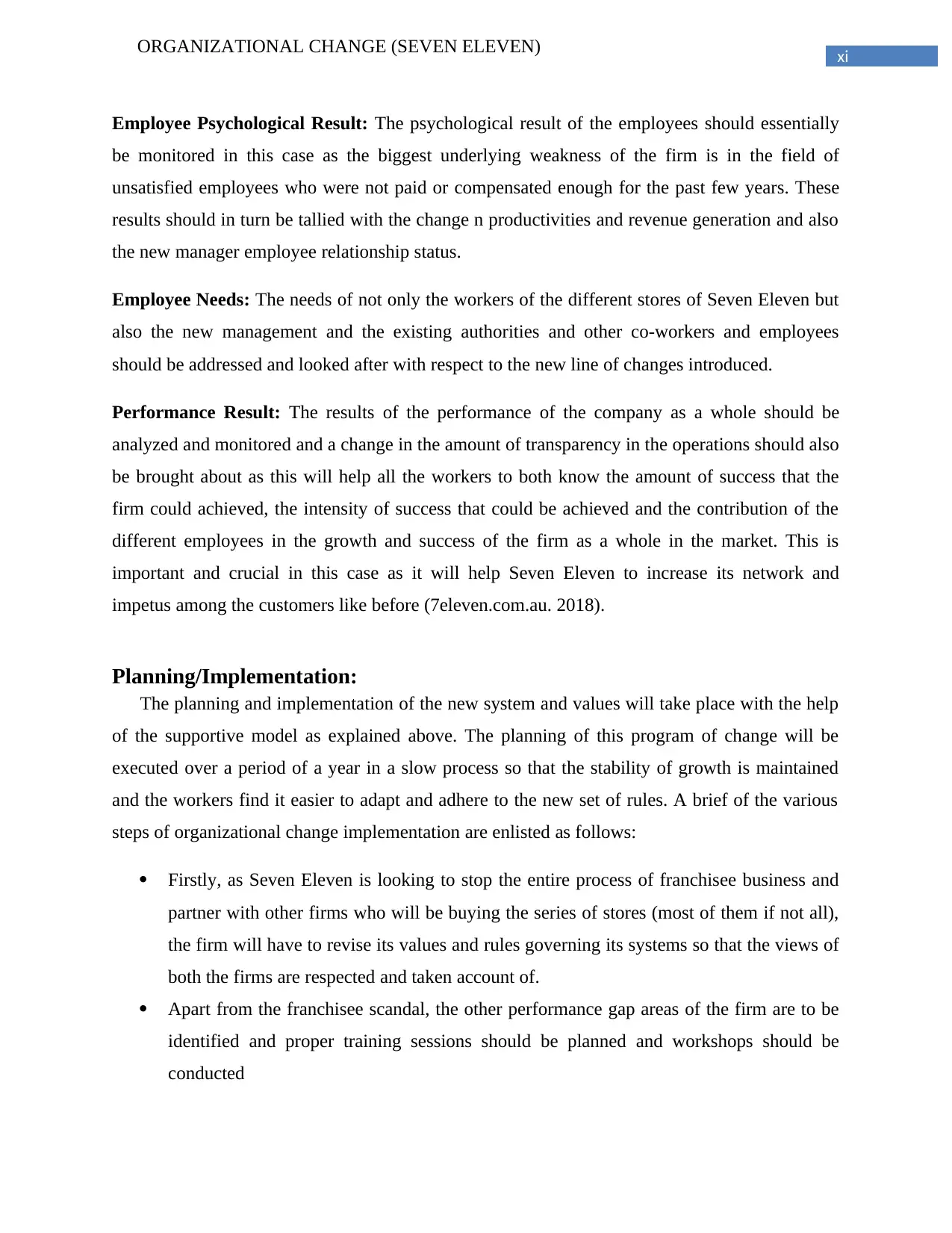
xi
ORGANIZATIONAL CHANGE (SEVEN ELEVEN)
Employee Psychological Result: The psychological result of the employees should essentially
be monitored in this case as the biggest underlying weakness of the firm is in the field of
unsatisfied employees who were not paid or compensated enough for the past few years. These
results should in turn be tallied with the change n productivities and revenue generation and also
the new manager employee relationship status.
Employee Needs: The needs of not only the workers of the different stores of Seven Eleven but
also the new management and the existing authorities and other co-workers and employees
should be addressed and looked after with respect to the new line of changes introduced.
Performance Result: The results of the performance of the company as a whole should be
analyzed and monitored and a change in the amount of transparency in the operations should also
be brought about as this will help all the workers to both know the amount of success that the
firm could achieved, the intensity of success that could be achieved and the contribution of the
different employees in the growth and success of the firm as a whole in the market. This is
important and crucial in this case as it will help Seven Eleven to increase its network and
impetus among the customers like before (7eleven.com.au. 2018).
Planning/Implementation:
The planning and implementation of the new system and values will take place with the help
of the supportive model as explained above. The planning of this program of change will be
executed over a period of a year in a slow process so that the stability of growth is maintained
and the workers find it easier to adapt and adhere to the new set of rules. A brief of the various
steps of organizational change implementation are enlisted as follows:
Firstly, as Seven Eleven is looking to stop the entire process of franchisee business and
partner with other firms who will be buying the series of stores (most of them if not all),
the firm will have to revise its values and rules governing its systems so that the views of
both the firms are respected and taken account of.
Apart from the franchisee scandal, the other performance gap areas of the firm are to be
identified and proper training sessions should be planned and workshops should be
conducted
ORGANIZATIONAL CHANGE (SEVEN ELEVEN)
Employee Psychological Result: The psychological result of the employees should essentially
be monitored in this case as the biggest underlying weakness of the firm is in the field of
unsatisfied employees who were not paid or compensated enough for the past few years. These
results should in turn be tallied with the change n productivities and revenue generation and also
the new manager employee relationship status.
Employee Needs: The needs of not only the workers of the different stores of Seven Eleven but
also the new management and the existing authorities and other co-workers and employees
should be addressed and looked after with respect to the new line of changes introduced.
Performance Result: The results of the performance of the company as a whole should be
analyzed and monitored and a change in the amount of transparency in the operations should also
be brought about as this will help all the workers to both know the amount of success that the
firm could achieved, the intensity of success that could be achieved and the contribution of the
different employees in the growth and success of the firm as a whole in the market. This is
important and crucial in this case as it will help Seven Eleven to increase its network and
impetus among the customers like before (7eleven.com.au. 2018).
Planning/Implementation:
The planning and implementation of the new system and values will take place with the help
of the supportive model as explained above. The planning of this program of change will be
executed over a period of a year in a slow process so that the stability of growth is maintained
and the workers find it easier to adapt and adhere to the new set of rules. A brief of the various
steps of organizational change implementation are enlisted as follows:
Firstly, as Seven Eleven is looking to stop the entire process of franchisee business and
partner with other firms who will be buying the series of stores (most of them if not all),
the firm will have to revise its values and rules governing its systems so that the views of
both the firms are respected and taken account of.
Apart from the franchisee scandal, the other performance gap areas of the firm are to be
identified and proper training sessions should be planned and workshops should be
conducted
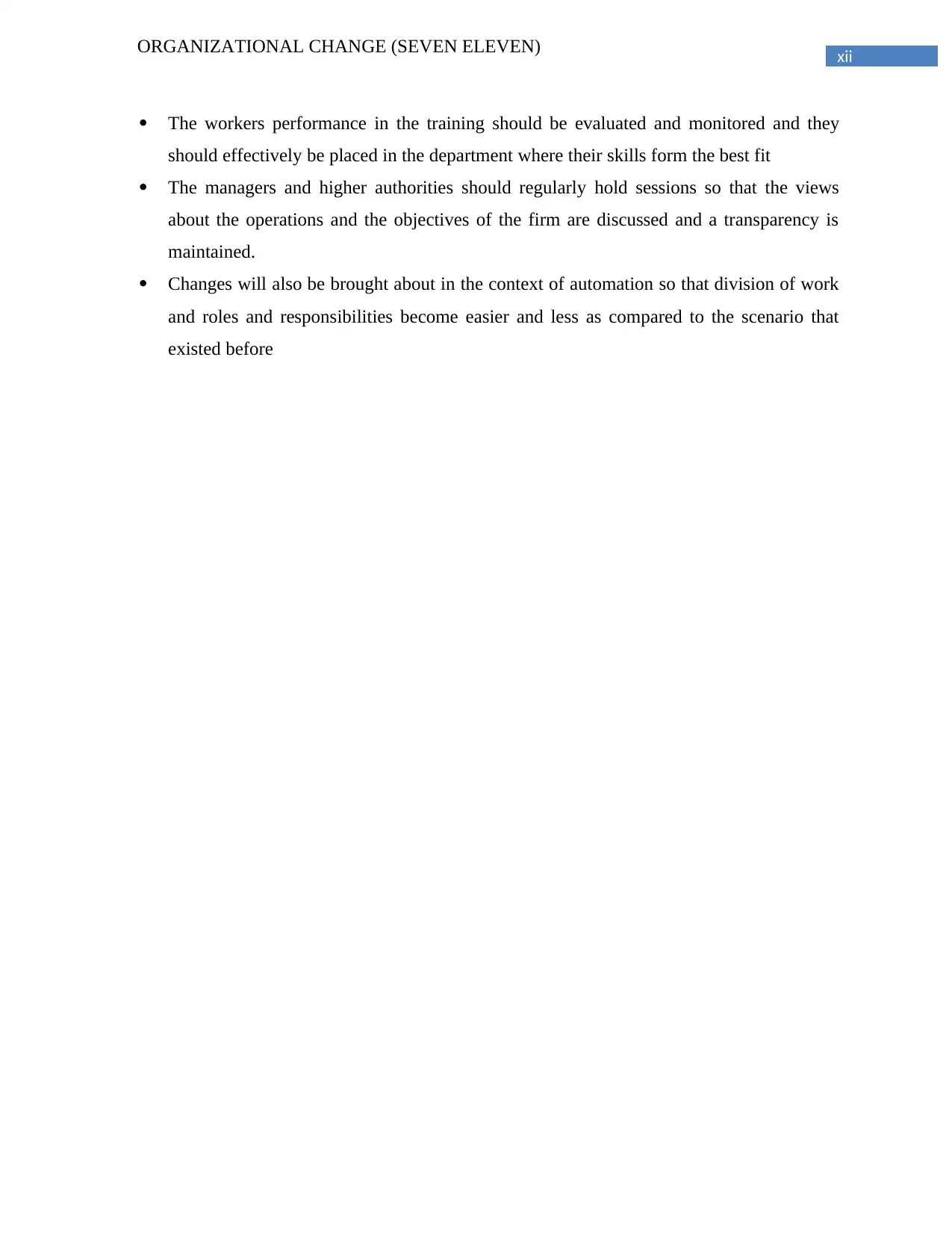
xii
ORGANIZATIONAL CHANGE (SEVEN ELEVEN)
The workers performance in the training should be evaluated and monitored and they
should effectively be placed in the department where their skills form the best fit
The managers and higher authorities should regularly hold sessions so that the views
about the operations and the objectives of the firm are discussed and a transparency is
maintained.
Changes will also be brought about in the context of automation so that division of work
and roles and responsibilities become easier and less as compared to the scenario that
existed before
ORGANIZATIONAL CHANGE (SEVEN ELEVEN)
The workers performance in the training should be evaluated and monitored and they
should effectively be placed in the department where their skills form the best fit
The managers and higher authorities should regularly hold sessions so that the views
about the operations and the objectives of the firm are discussed and a transparency is
maintained.
Changes will also be brought about in the context of automation so that division of work
and roles and responsibilities become easier and less as compared to the scenario that
existed before
⊘ This is a preview!⊘
Do you want full access?
Subscribe today to unlock all pages.

Trusted by 1+ million students worldwide
1 out of 16
Related Documents
Your All-in-One AI-Powered Toolkit for Academic Success.
+13062052269
info@desklib.com
Available 24*7 on WhatsApp / Email
![[object Object]](/_next/static/media/star-bottom.7253800d.svg)
Unlock your academic potential
Copyright © 2020–2025 A2Z Services. All Rights Reserved. Developed and managed by ZUCOL.





